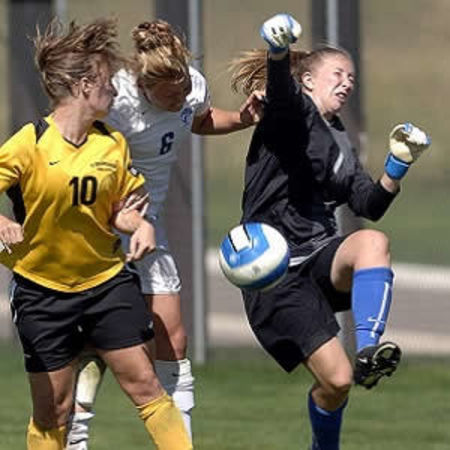A new imaging study from Albert Einstein College of Medicine, part of Montefiore, provides further insight into the risk of brain damage caused by repeated soccer heading. The study assessed changes in brain tissue of soccer players, both men and women, and results show that women are more likely than men to suffer brain trauma from heading soccer balls.
According to researchers, they found that regions of damaged brain tissue were five times more extensive in female soccer players than in males, suggesting that sex-specific guidelines may be warranted for preventing soccer-related head injuries. Their findings are published online in the journal Radiology.
Researchers performed diffusion tensor imaging (DTI), a form of MRI, on 49 male and 49 female amateur soccer players enrolled in the Einstein Soccer Study. Both groups ranged in age from 18-50 with a median age of 26, and both groups reported a similar number of headings over the previous year (an average of 487 headings for the men and 469 for the women).
DTI detects subtle brain damage by measuring the direction of the diffusion of water in white matter, the deep brain tissue that coordinates communication between brain regions. The more uniform the diffusion of water — measured on a zero-to-one scale called fractional anisotropy (FA) — the better the microstructural integrity of the tissue. Finding a low-FA brain region indicates structural damage to the brain.
Assessment of FA in players’ brains showed that the volume of damaged white matter in women soccer players was five times greater than for male players. The women had eight brain regions where greater levels of heading were associated with lower FA compared with only three regions in men, the researchers noted.
"The findings add to the growing body of evidence that men and women express distinct biological responses to brain trauma," said the study's lead author Todd G. Rubin, MS, an MD-PhD student in the Translational Neuroimaging Laboratory at Einstein.
Just why women might be more sensitive to head injury than men isn't known. Researchers speculate that differences in neck strength, sex hormones or genetics could play a role. The changes in FA were subclinical, meaning they didn’t produce overt clinical findings such as altered thinking ability. Still, those FA changes are cause for concern, according to study leader Michael L. Lipton, MD, PhD, professor of radiology and of psychiatry and behavioural sciences at Einstein and medical director of MRI Services at Montefiore.
"In various brain injuries, including chronic traumatic encephalopathy [a degenerative brain disease found in athletes, military veterans, and others with a history of repetitive brain trauma], subclinical pathology develops before we can detect brain damage that affects function," Dr. Lipton explained. "So before serious dysfunction occurs, it's wise to identify risk factors for cumulative brain injury — such as heading if you’re female — so that people can act to prevent further damage and maximise recovery."
For more than a decade, Dr. Lipton has studied the effects of mild brain injury and the cumulative effects of repetitive subconcussive injury on the brains of amateur athletes and combat veterans. He previously found that frequent soccer ball heading is a common and under-recognized cause of concussion symptoms and that worse cognitive function in soccer players stems mainly from frequent ball heading rather than from unintentional head impacts due to collisions.
Video Credit: Albert Einstein College of Medicine
Image Credit: Pixabay
Latest Articles
brain trauma, soccer heading, women and brain damage
A new imaging study from Albert Einstein College of Medicine, part of Montefiore, provides further insight into the risk of brain damage caused by repeated soccer heading. The study assessed changes in brain tissue of soccer players, both men and women, a























